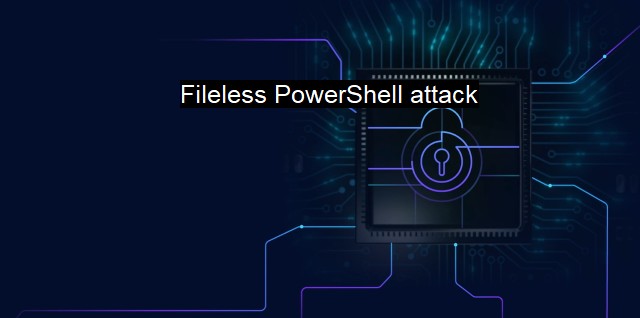What is Fileless PowerShell attack?
The Threat of Fileless PowerShell Attacks and How They Operate: An Emerging Cybersecurity Concern
A "Fileless PowerShell attack" is an advanced form of cyber attack that poses a significant risk to security systems and antivirus software. In this type of attack, PowerShell shell scripting language, which is native to Microsoft Windows, is leveraged and exploited by cybercriminals. It is considered fileless since it often doesn't require any malicious software or files to be written to the targeted system's hard disk, making it increasingly difficult for traditional security measures to detect and counter.PowerShell is a powerful scripting language and automation framework embedded in the Windows OS. It permits unparalleled access to the underlying system, giving system administrators the ability to effectuate subprocesses like changing registry settings, modify file systems, and access networks, among much more. While this tool is administratively efficient and effective, it poses a considerable risk when used maliciously, offering a conduit for attackers to infiltrate and manipulate systems undetected.
The fileless nature of PowerShell attacks offers several advantages to cybercriminals, which is why they have become an increasingly popular technique in recent times. In a typical attack, an adversary uses an innocent-looking file or link to trigger a PowerShell script. This can often be accomplished through a user clicking on a link or opening an email attachment. Once triggered, the fileless PowerShell script runs directly within the computing device's memory (RAM) instead of getting written onto the hard disk.
What makes it so dangerous is its elusiveness. Traditional security measures like antivirus software operate primarily by scanning files on a disk for known matches of malware. since a Fileless PowerShell Attack does not exist on a disk as it operates directly in the memory, there are no files to analyze makings its detection challenging. It also leaves little to no residue while operating or even post-execution, further hampering investigatory measures.
PowerShell scripts vest an impressive degree of control and flexibility to threat actors. These scripts can be customized to specific cybercrime objectives, be it triggering certain processes on the machine, downloading additional payloads from the internet, or exfiltrating sensitive data. A knowledgeable adversary can automate widespread malicious activities, executing commands across networks, and potentially opening doors to even more damaging secondary attacks.
Equally important to note is that PowerShell is an inherently legitimate tool in Windows. Cybersecurity defenses are devised to spot and defend against externally, nefariously installed programs. concentrating on these traditional threats can lead to ignoring intrusions established through PowerShell manipulations. This calculating discrepancy is something threat actors utilize strategically, add to that the veil of filelessness, makes PowerShell attacks one of the cardinal advanced persistent threat (APT) strategies.
Countering the growing PowerShell Attack requires a more layered defense approach. A proactive defense stance with continuous monitoring of network traffic is instrumental in detecting unusual activity. Restricting and controlling the use of PowerShell within an organization is also essential. User-behavior analytics can be handy, coupled with the whitelisting of scripts, in managing the risk associated with the utilization of PowerShell. It also requires regular auditing, stringent access control, and employee training to refrain from clicking on unverified links or opening suspicious files.
The Fileless PowerShell attack exemplifies the evolving nature of cyber threats in today's interconnected world. As they continue to evolve, cybersecurity protocols must also adapt swiftly and efficiently. Recognizing these fileless threats and designing defenses to counteract them has become vital in the practice of information security. Understanding PowerShell attacks is the first step towards progressing security measures and building more a resilient IT environment.

Fileless PowerShell attack FAQs
What is a fileless PowerShell attack?
A fileless PowerShell attack is a type of cyber attack that leverages the PowerShell scripting language to execute malicious code in memory without writing any files to disk. This makes it more difficult for traditional antivirus solutions to detect and block the attack.How does a fileless PowerShell attack work?
A fileless PowerShell attack typically begins with an attacker gaining access to a system. The attacker then uses PowerShell commands and scripts, often disguised as legitimate administration tasks, to download and execute malicious code directly in memory. Since no files are written to disk, traditional antivirus solutions have a harder time detecting and blocking this type of attack.Can antivirus software detect fileless PowerShell attacks?
Some antivirus software can detect common fileless PowerShell attack techniques, but as attackers continually develop new tactics, it can be difficult for antivirus solutions to keep up. The best defense against fileless PowerShell attacks is a multi-layered approach that includes endpoint detection and response (EDR), network security, and employee education.How can organizations protect against fileless PowerShell attacks?
Organizations can protect against fileless PowerShell attacks by implementing best practices such as patching regularly, disabling unnecessary PowerShell functionality, and monitoring for suspicious activity. Additionally, having a robust backup strategy and disaster recovery plan can help organizations respond quickly in the event of an attack. Employee education is also crucial in preventing successful attacks, as many fileless PowerShell attacks start with social engineering tactics such as phishing emails.| | A | | | B | | | C | | | D | | | E | | | F | | | G | | | H | | | I | | | J | | | K | | | L | | | M | |
| | N | | | O | | | P | | | Q | | | R | | | S | | | T | | | U | | | V | | | W | | | X | | | Y | | | Z | |
| | 1 | | | 2 | | | 3 | | | 4 | | | 7 | | | 8 | | |||||||